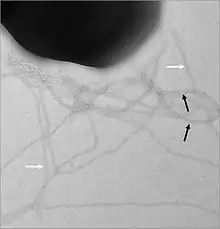TACK
| TACK | |
|---|---|
 | |
| Sulfolobus | |
| Scientific classification | |
| Domain: | |
| Kingdom: | |
| Superphylum: | TACK Guy & Ettema 2011 |
| Phyla[1] | |
| |
| Synonyms | |
| |
TACK is a group of archaea acronym for Thaumarchaeota, Aigarchaeota, Crenarchaeota and Korarchaeota, the first groups discovered. They are found in different environments ranging from acidophilic thermophiles to mesophiles and psychrophiles and with different types of metabolism, predominantly anaerobic and chemosynthetic.[2] TACK is a clade that is close to the branch that gave rise to the eukaryotes. It has been proposed that the TACK clade be classified as Crenarchaeota and that the traditional "Crenarchaeota" be classified as a class called "Sulfolobia", along with the other phyla with class rank or order.[3]
Classification
- Crenarchaeota. It is the best known edge and the most abundant archaea in the marine ecosystem. They were previously called sulfobacteria because of their dependence on sulfur and are important as carbon fixers. There are hyperthermophiles in hydrothermal vents and other groups are the most abundant at depths of less than 100 m.
- Aigarchaeota. It is a phylum proposed from the genome of the candidate species Caldiarchaeum subterraneum found deep within a gold mine in Japan. Genomic sequences of this group have also been found in geothermal environments, both terrestrial and marine.
- Geoarchaeota. It includes thermophilic organisms that live in acidic environments reducing ferric iron. Alternatively it has been proposed that this and earlier group actually belong to the phylum Thaumarchaeota.
- Thaumarchaeota. It includes mesophilic or psychrophilic organisms (medium and low temperatures), of ammonia-oxidant chemolytoautotrophic metabolism (nitrifying) and that can play an important role in biochemical cycles, such as the nitrogen and carbon cycles.
- Bathyarchaeota. It is abundant in the sediments of the seabed with a shortage of nutrients. At least some lineages develop through homoacetogenesis, a type of metabolism hitherto thought unique to bacteria.
- Korarchaeota. They have only been found in hydrothermal environments and in low abundance. They seem diversified at different phylogenetic levels according to temperature, salinity (fresh or marine water) and geography.
Phylogeny
The relationships are roughly as follows:
| McKay et al. 2019[4] | GTDB release 06-RS202 (26 April 2021).[5][6][7] | |||||||||||||||||||||||||||||||||||||||||||||||||||||||||||||||||||||||||||||||||||||||||||||||||||||||||||||||||||||||||||
|---|---|---|---|---|---|---|---|---|---|---|---|---|---|---|---|---|---|---|---|---|---|---|---|---|---|---|---|---|---|---|---|---|---|---|---|---|---|---|---|---|---|---|---|---|---|---|---|---|---|---|---|---|---|---|---|---|---|---|---|---|---|---|---|---|---|---|---|---|---|---|---|---|---|---|---|---|---|---|---|---|---|---|---|---|---|---|---|---|---|---|---|---|---|---|---|---|---|---|---|---|---|---|---|---|---|---|---|---|---|---|---|---|---|---|---|---|---|---|---|---|---|---|---|---|
|
|
References
- ↑ Castelle CJ, Banfield JF. (2018). "Major New Microbial Groups Expand Diversity and Alter our Understanding of the Tree of Life". Cell. 172 (6): 1181–1197. doi:10.1016/j.cell.2018.02.016. PMID 29522741.
{{cite journal}}: CS1 maint: uses authors parameter (link) - ↑ Guy & Ettema 2011, The archaeal 'TACK' superphylum and the origin of eukaryotes. Trends Microbiol. 2011 Dec;19(12):580-7. doi:10.1016/j.tim.2011.09.002. Epub 2011 Oct 20.
- ↑ Cavalier-Smith, Thomas; Chao, Ema E-Yung (2020). "Multidomain ribosomal protein trees and the planctobacterial origin of neomura (Eukaryotes, archaebacteria)". Protoplasma. 257 (3): 621–753. doi:10.1007/s00709-019-01442-7. PMC 7203096. PMID 31900730.
- ↑ McKay, L.J., Dlakić, M., Fields, M.W. et al. Co-occurring genomic capacity for anaerobic methane and dissimilatory sulfur metabolisms discovered in the Korarchaeota. Nat Microbiol 4, 614–622 (2019) doi:10.1038/s41564-019-0362-4
- ↑ "GTDB release 06-RS202". Genome Taxonomy Database. Retrieved 6 December 2021.
- ↑ "ar122_r202.sp_label". Genome Taxonomy Database. Retrieved 6 December 2021.
- ↑ "Taxon History". Genome Taxonomy Database. Retrieved 6 December 2021.